Tuning of NaTaO3 Band Structure through Mn2+ Ion Doping and the Enhanced Visible Light Response①
LI Guo-Xia Yang Xu HAI Li-Si Chai Zhan-Li Wang Xiao-Jing
?
Tuning of NaTaO3Band Structure through Mn2+Ion Doping and the Enhanced Visible Light Response①
LI Guo-Xia Yang Xu HAI Li-Si Chai Zhan-Li Wang Xiao-Jing②
(010021)
Pure and Mn-doped NaTaO3nanoparticles were synthesized by a simple hydro- thermal method. XRD andXPS results suggested that manganese ions were successfully doped into the NaTaO3crystalline in Mn2+state. UV-vis diffuse reflectance spectra revealedthe obvious red-shift in the series of manganesedoped NaTaO3nanoparticles, resulting in a decrease in the band gap of NaTaO3with the increase of Mn2+doping concentration. The photo-degradation experiment indicated that manganese doped NaTaO3showed good photocatalytic performance and methylene blue(MB) degradation is improved with lower doping concentration of manganese ionsunder visible light. The simulation of energy band structure by density functional theory unfolded that thesubstitution of Ta5+ions by Mn2+ions resulted in an intermediate band (IB) below the bottom of the conduction band (CB), which was mainly attributed to the state of Mn 3.
manganese doped NaTaO3, hydrothermal method, photocatalyst, density functional theory
1 INTRODUCTION
Semiconductor material has gained considerable attention as a promising photocatalyst to tackling the issues of energy shortage and environmental pol- lution[1-2].Considering the economic aspect and con- venient application, the greatest challenge is still to increase the effective utilization of solar energy which is closely related to the energy band structure of semiconductor.Among the different strategies to obtain photocatalysts activated by visible-light illumination, the most promising results have been achieved by doping photocatalysts with either non- metals (B,N, C, S or I)[3–7]or metal ions (e.g. V, Cr, Fe, Co, Cu, Zn, Bi, La,.)[8–15]. Manganese ion was found to be attractive dopantfor the effective modification of photocatalysts, through the com- bined effects of narrowed band gap and the introduc- tion of intermediate bands (IBs) within the forbidden gap[16–20]. Q. R. Deng. reported that a remar- kable red shift of the absorption edge was achievable for Mn-doped TiO2nanopowders by increasing the manganese ion content, leading to gigantically narrowed energy gap[16]. Brijesh Pare[17]described a shift in the optical absorption edge towards higher wavelength and a decrease in the band gap upon Mn doping for BiOCl photocatalyst. However, K. Rekha[18]found a blue shift in the absorbance spectrum with increasing the dopant concentration of manganese ions for a wurtzite structure ZnO. Donkova[19]investigated the influence of manganese ion dopant on the band structure para- meters of ZnO matrixs. The research by L. Gomathi Devi indicated the enhanced photocatalytic activity of Mn2+(0.06 at.%)-TiO2should be attributed to the combined factors of high positive reduction potential of Mn2+/Mn3+pairs and synergistic effects in the mixed polymorphs of anatase and rutile[20].
It has been well-documented now that NaTaO3is superior to other semiconductors such as TiO2in photocatalytic oxidationdue to its very positive elec- trochemical potential, which allows NaTaO3-based photo-catalyst to be more efficient in photo-splitting water to produce hydrogen and photo-degrading organic substances[21-28]. However, the applications are seriously limited by the intrinsic wide energy gaps of NaTaO3of 4.0 eV, which confines the NaTaO3materials can only work under ultraviolet light.This work is aimed to reveal the mechanism of increasing optical absorption via manganese doping. The uniformly and highly dispersed Mn2+ions incorporated tantalate was prepared. The regulation of the optical absorbance and band structure by Mn2+doping was investigated.
2 EXPERIMENT AND CALCULATION DETAILS
The manganese doped NaTaO3nanoparticles were prepared by a hydrothermal method similar to that for NaTaO3nanoparticles[7, 28]. 0.01 mol Ta2O5, 9.0 g NaOH, Mn(NO3)2and 22.5 mL deionized water were fully mixed with magnetic stirring and then added into a Teflon-lined autoclave with a capacity of 30 mL. The amount of Mn2+is 5%, 10%, 20%, 30%, 40% and 50% in a weight ratio, respectively. The autoclave was sealedand maintained at 200 ℃ for 24 h. After cooling naturally to room temperature in air, the mixture was filtered and washed with distilled water, and then dried in air at 60 ℃ for 12 h. The products were denoted as NaTaO3, 0.05 Mn-NaTaO3, 0.1 Mn-NaTaO3, 0.2 Mn-NaTaO3, 0.3 Mn-NaTaO3, 0.4 Mn-NaTaO3and 0.5 Mn-NaTaO3.
The structure and crystallinity of the NaTaO3and Mn-doped NaTaO3samples were characterized by powder X-ray diffraction (XRD) on a D8 Advance Bruker X-ray diffractometer equipped with a gra- phite-monochromatized Moradiation (l.5416 ?). The morphology of the samples was explored by an FEI Tecnai F20 S-Twin transmission electron microscope (TEM) and high resolution transmission electron microscopy (HRTEM). X-ray photoelectron spectroscopy (XPS) analysis was carried out by using an Amicuso (KRATOS, English) with a monochromatic Al KR source of 1486.6 eV and a charge neutralizer. All binding energies were re- ferred to the C 1peak at 284.8 eV of the surface adventitious carbon with a corrected value of 4.4 eV. The specific surface areas of the samples were determined from the nitrogen absorption data at liquid nitrogen temperature using a Barrett-Emmett- Teller (BET) technique on a Micromeritics ASAP 2000 Surface Area and Porosity Analyzer. A dif- fusive reflectance UV–Vis spectrophotometer (UV- Vis, Perkin-Elmer Lambda35) was employed to measure the UV-Vis absorption and to estimate the band gap of the samples. BaSO4was taken as the reference sample, and the spectra were recorded in the range of 200~1100 nm. The band gap of the samples was estimated from the onset of the absorption using the formula(eV) = 1240/g(nm).
The electron and energy band structure of NaTaO3and Mn-doped NaTaO3crystals were calculated by Cambridge sequential total energy package (CAS- TEP)[29]based on density functional theory (DFT) in Material Stadio (MS4.5). Lattice parameters and atomic positions of NaTaO3were optimized by minimizing the total energy.Generalized gradient approximation (GGA) of Perdew-Burke-Ernzerhof (PBE) is used to describe the exchange-correlation energy function[30].The ultrasoft pseudopotential[31]is used for the interaction between ion core and valence electron. Wave functions of the valence electrons were expanded to a basis set of planewaves within specified cutoff energy (cut=350 eV) and the number of-points network in Brillouin zone is set to 2×4×1. Furthermore, the optimization of Mn-doped NaTaO3wasperformed based on the optimal structural constants of NaTaO3without imposing any symmetry. The spin polariza- tion was not considered in this work because the concerning was only focused on the difference of energy band for doping and un-doping NaTaO3systems. Theenergetic convergence threshold for self-consistent iteration was set at 2′10-5eV and structural relaxation is carried out until all com- ponents of the residual forces were smaller than 0.03 eV/?. The total density of states (TDOS) and the projected density of states (PDOS) for the non- doped NaTaO3and Mn-doped NaTaO3were calcula- ted using the tetrahedron method with Blochl correc- tions.
Photocatalytic activities of the samples were evaluated by degradation of methylene blue(MB) under the visible-light irradiation with a SGY-I photochemical reactor. A 500 W Xe lamp (> 420 nm) was placed inside the reactor after carefully removing the outer shell. The suspension of 2×10-4mol/L MB mixed with 50 mg catalyst was stirred continuously for 120 min in the dark before reaction. Then the absorbency of the sample solution was detected volumetrically at a certain time with a UV-visible spectrometer (UV-7504PC, China) and was used to calculate the photodegradation rate of MB.
3 RESULTS AND DISCUSSION
XRD determination was used to confirm the cry- stallinity and phase purity of both undoped and Mn-doped NaTaO3samples. Standard Si was mixed with the sample when the XRD experiment was performed for the purpose to revise the instrumental error. As indicated in Fig. 1, diffraction peaks ma- tched well with the standard data for orthorhombic phase NaTaO3(JCPDS No. 25-0863). It appears that theMn2+doping did not result in significant structural changes for NaTaO3. Furthermore, a systematic shift toward bigger angles was observed for the enlarging (020) peak in the Mn-doped samples (Inset in Fig. 1) which may attribute to the cell shrinkage caused by the Ta5+ions substituted by Mn2+ions. As we know, there are three charge differences for Mn2+and Ta5+ions although the ionic radius of Mn2+(0.067 nm) is close to that of Ta5+ions (0.064 nm). Thus the oxygen vacancies would be produced with the addition of Mn2+ions, which is proved by the cell shrinkage.The existence of Mn2+ions was further confirmed by high resolution X-ray photoelectron spectroscopy (XPS). As revealed in Fig. 2, XPS spectra of Mn-doped NaTaO3indicate the existence of Ta, O, and Mn elements. XPS peaks of Ta 4appeared at 27.0 eV after correction, while O 1shows a major peak around 529.2 eV that is attributed to the bulk oxygen (O2-). Two weaker peaks at 652.8 and 641.2 eV were identified as Mn 21/2 and 23/2. According to the literatures[32], this value indicates that manganese mainly exists as the chemical state of Mn2+ions on the sample surface. The data of XRD and XPS proved the manganese ions have been well incorporated in the crystalline of NaTaO3in our samples.
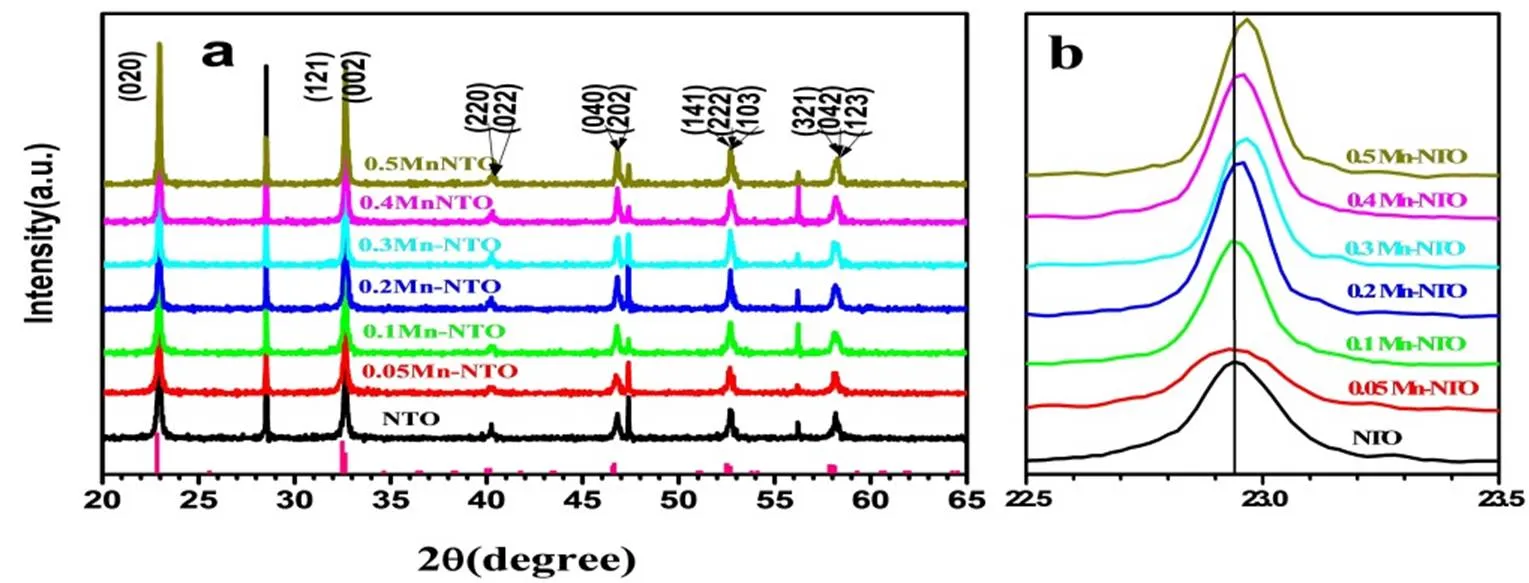
Fig. 1. (a) XRD patterns of NaTaO3with different dopant levels of Mn2+. (b) Inset showing the enlarging (020) peak
Fig. 2. XPS spectrum of 0.3 Mn-doped NaTaO3
The doping of Mn2+did not apparently alter the particle shape, but exhibited a fairly rough, irregular surface with a finer size with the addition of Mn2+ion, as observed by TEM (Fig. 3). Fig. 3a inset shows an HRTEM image of the pure NaTaO3sample with the lattice spacing of 0.3882 nm, corresponding to the crystal plane (020) of the orthorhombic cell, while the lattice-spacing was 0.3770 nm for 0.30 Mn-doped NaTaO3(Fig. 3b inset), and the decrease of the lattice-spacing indicated the contractive cell volume.
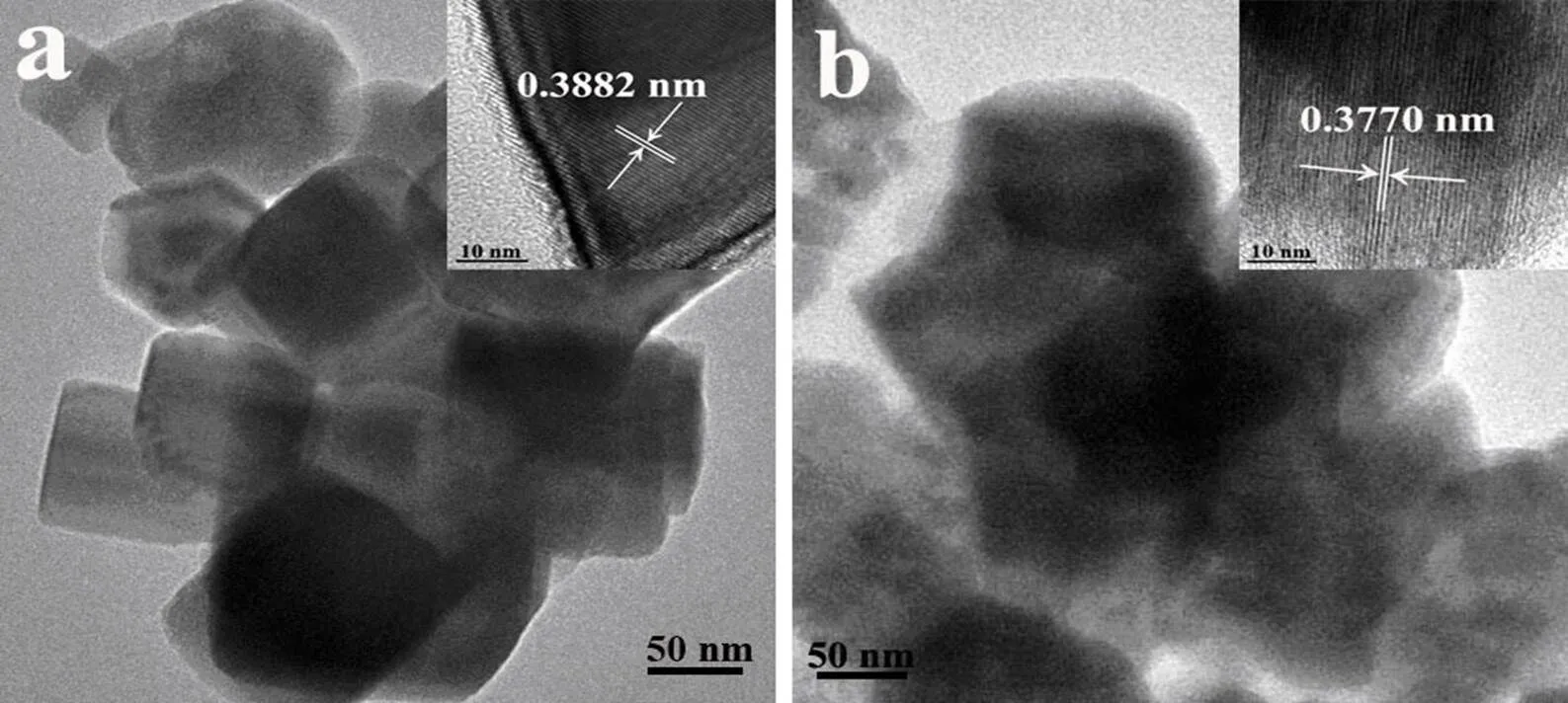
Fig. 3. TEM images of NaTaO3nanocrystals. (a) Non-doped NaTaO3, (b) Mn-doped NaTaO3
The visible-light response with the doping of Mn2+ions was detected by UV-Vis absorption spectra (Fig. 4). The absorption spectrum for pure NaTaO3powder shows a steep absorption around 300 nm, which corresponded to the intrinsic electron excitation from the valence to the conduction band of semiconductor. Compared with the spectrum of pure tantalates, the red-shift was clearly observed in the series of Mn2+doped NaTaO3catalysts. The effect became more prominent with increasing the manganese ion concentration. When the doping level reached 50%, the optical absorption was extended obviously into the infrared spectral range. Con- sistently, the band gap energy decreased from 4.13 to 1.85 eV (as shown in the Inset of Fig. 4). This indicated that the doping of Mn2+ions led the red shift of the absorption edge well into the visible regions.
To investigate the mechanism of manganese doping, the band structure and density of states were calculated using CASTEP code.The 2 × 2 × 2 supercell containing 40 atoms wasconstructed for pure NaTaO3andMn-doped NaTaO3by substituting a Mn atomfor Ta atom, giving a doping level of 1/4 (Fig. 5). The structure of the energy band is con- sistently with the results we have reported previou- sly[7, 9, 27], as illustrated in Figs. 6 and 7. The con- duction band of NaTaO3consisted mainly of the unoccupied Ta5orbital, especially in the lower energy region (2~5 eV), while O 2states dominate at the top of the valence bands. When the Mn ions are intercalated into NaTaO3, a new band associated with Mn 3electrons lies just across the Fermi energy. Upon irradiation with solar light, elec- tron-hole pair is generated within the effective band gap, i.e., electron transition excitation requires smaller excitation energy as compared to the native band gap (4.13 eV) of NaTaO3, depending upon the Mn2+dopant level within the band gap.This new band subsequently causes red shift in the optical absorption of Mn2+-doped NaTaO3nanoparticles.
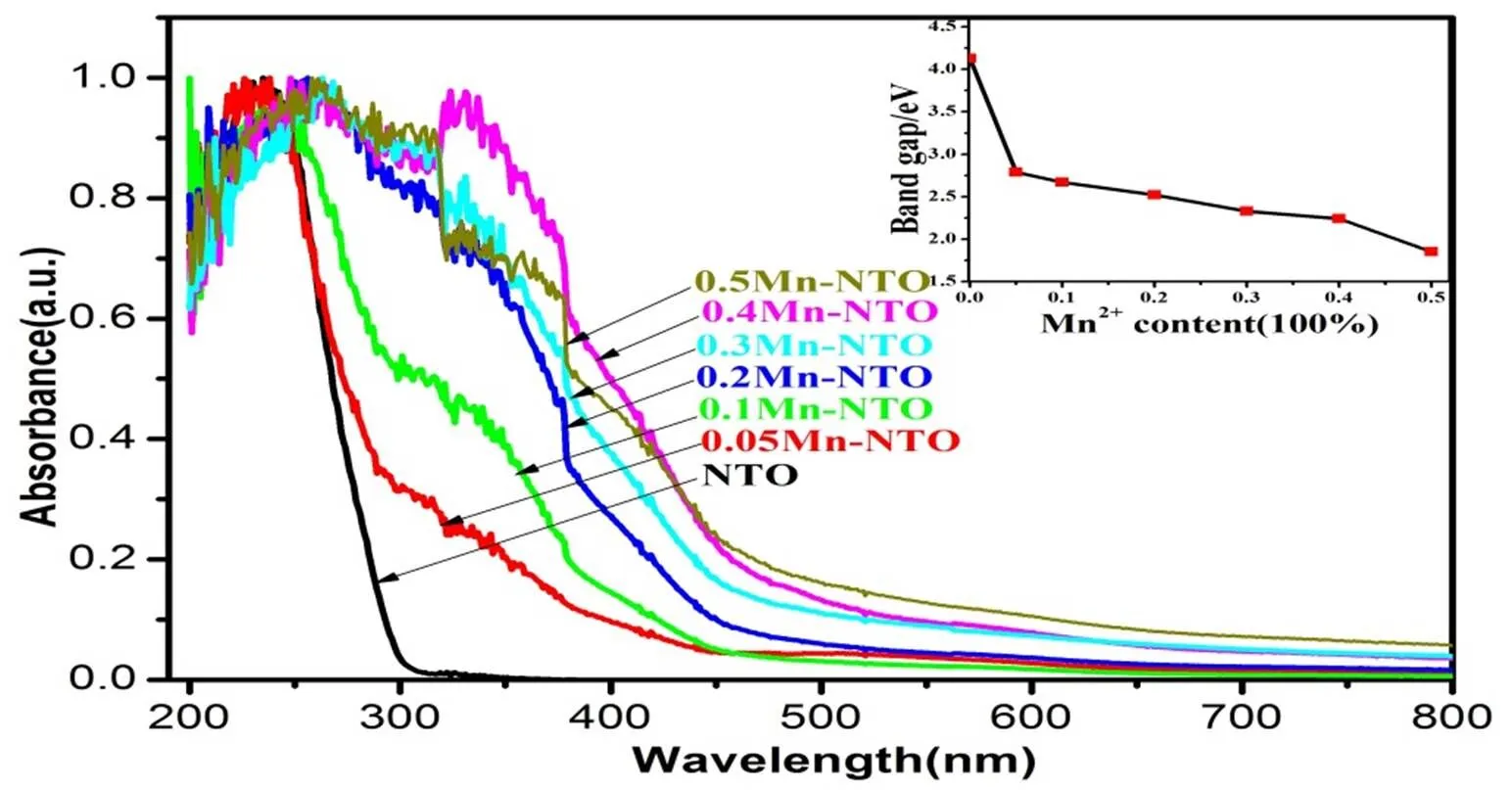
Fig. 4. Diffuse reflectance spectrum of NaTaO3with different dopant levels of Mn2+. Inset showing the band gap of Mn2+doped NaTaO3
Fig. 5. Supercell model of NaTa0.875Mn0.125O3
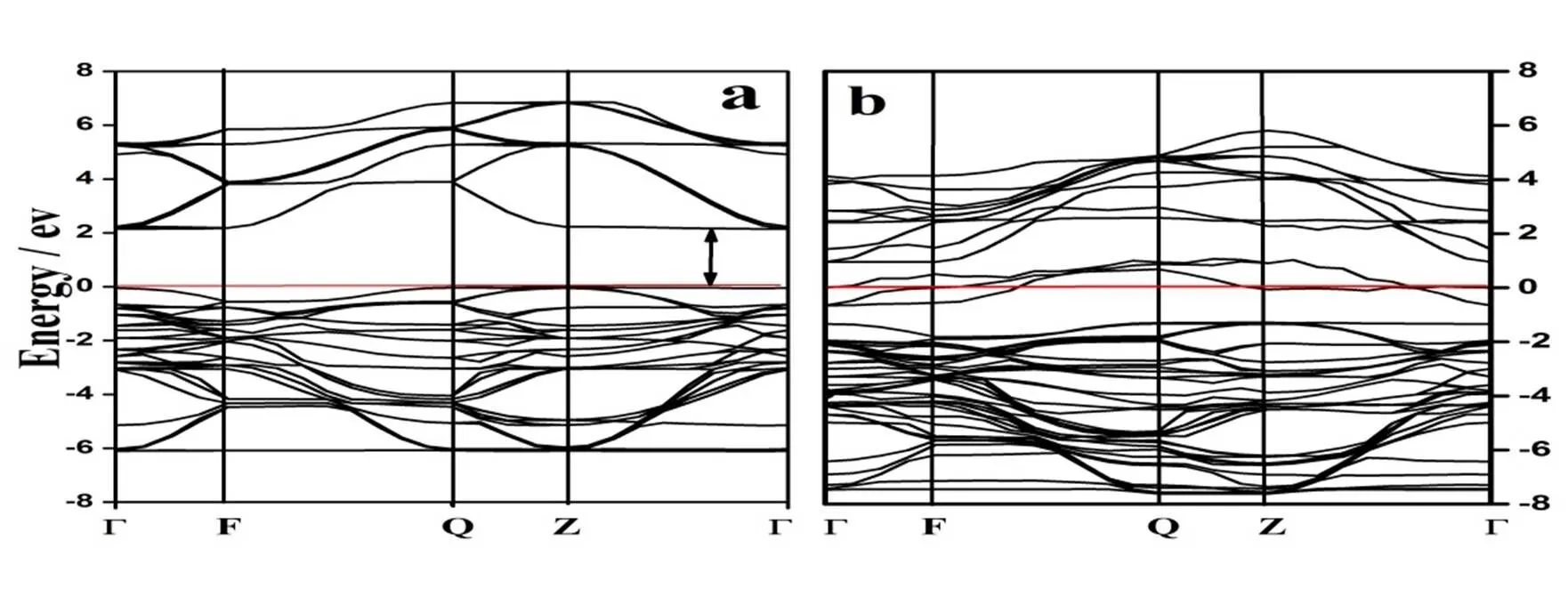
Fig. 6. DFT-calculated band gap structure. (a) pure NaTaO3(b)NaTa0.875Mn0.125O3
Fig. 7. Density of states. (a) pure NaTaO3(b) NaTa0.875Mn0.125O3
The influence of manganese ion doping on the photocatalytic activity was tested by the degradation of methylene blue (MB) solutions (Fig. 8). It has been shown that the photocatalytic activity of doped NaTaO3is strongly dependent on thedopant con- centration. The 0.5 Mn-doped NaTaO3shows ex- cellent activity with the degradation rate of MB up to 75% at 200 min under the irradiation of visible light. The presence of Mn2+ions in the reaction solution was not determined, indicating that there are no soluble Mn2+ions in our samples. The im- proved activity of 0.05 Mn-doped NaTaO3can be attributed to the excellent optical absorbance ability and larger specific surface area. The specific surface area was 14.53 and 20.36 m2/g for non-doped NaTaO3and0.05 Mn-doped NaTaO3, respectively. Larger surface area may be an important factor for thephotocatalyticdegradation reactions, as large amount of pollutant can beadsorbed so as to pro- mote the interfacial charge transfer rate. However, further increasing the doping levels led to the decrease in the photocatalytic activities, as observed in Fig. 7. When the doping concentration becomes too high, a great many crystal defects could be induced, which may serve as the recombination centers of hole and electrons to reduce photo- catalytic activity. Also, it is found the specific sur- face area with increasing the Mn2+concentration becomes smaller with a value of only 3.85 m2/g for 50 Mn-doped NaTaO3,which also confirms the low activities of degradationmethylene blue in our experiment.
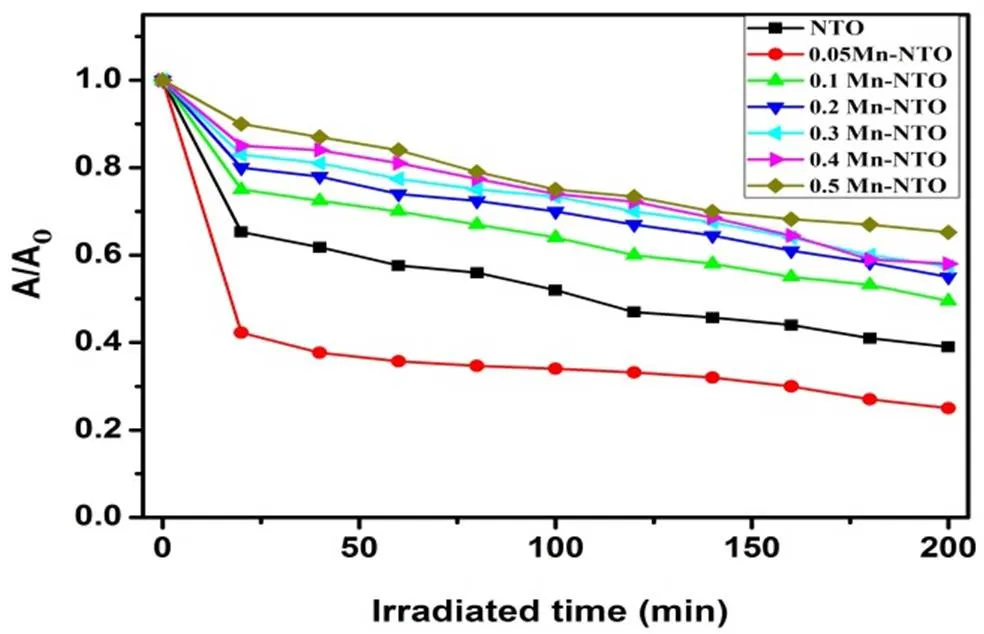
Fig. 8. Degradation curves of methylene blue solution under visible-light irradiation over NaTaO3when doped with different amounts of Mn2+
4 CONCLUSION
In this work, well-crystallized Mn-doped NaTaO3nanoparticles were synthesized by a facile hydro- thermal method. The data of XRD and XPS showed the Mn2+ions were incorporated in the crystalline of NaTaO3with a contractive cell volume.A remar- kable red shift of the absorption edge was achievable by increasing the Mn2+ion content, implying the controlling role on the band gap by manganese ion doping. The strong visible-light response was con- sidered originating from the intraband transition of the partially filled Mn 3bands to the conduction band. The lower doping concentration of Mn2+ions presented photocatalytic properties superior to those of the undoped NaTaO3, which was explained as the larger surface area and an excellent optical absor- bance performance. However, the increasing doping concentration may lead to the decrease of degra- dation activities due to the formation of capture center by excess Mn2+for electrons or holes as well as the decreasing surface area. The doping of manganeseprovides a promising strategy to improve the photoactivity of tantalate under visible light.
(1) Richter, R. D.; Caillol, S. Fighting global warming: the potential of photocatalysis against CO2, CH4, N2O, CFCs, tropospheric O3, BC and other major contributors to climate change.. 2011,12, 1-19.
(2) Fujishima, A.; Zhang, X. T.; Tryk, D. A. Heterogeneous photocatalysis: from water photolysis to applications in environmental cleanup.2007, 32, 2664-2672.
(3) Wu, Y. M.; Xing, M. Y.; Zhang, J. L. Gel-hydrothermal synthesis of carbon and boron co-doped TiO2and evaluating its photocatalytic activity.2011,192, 368-373.
(4) Cong, Y.; Li, X. K.; Lai, X. J. Carbon-doped TiO2coating on multiwalled carbon nanotubes with higher visible light photocatalytic activity.2011, 107, 128-134.
(5) Yan, G. T.; Zhang, M.; Yang, J. J.Photoelectrochemical and photocatalytic properties of N + S co-doped TiO2nanotube array films under visible light irradiation.. 2011, 129, 553-557.
(6) Wang, P. H.; Zhou, T.; Wang, R.; Lim, T. T. Carbon-sensitized and nitrogen-doped TiO2for photocatalytic degradation of sulfanilamide under visible-light irradiation.. 2011, 45, 5015-5026.
(7) Han, P. L.; Su, Y. G.; Meng, Y.; Wang, S. W.; Jia, Q. Y.; Wang, X. J. Preparation and photocatalytic performance of iodine-doped NaTaO3nanoparticles.. 2011, 11, 9600-9606.
(8) Hameed, A.; Gondal, M. A.; Yamani, Z. H. Effect of transition metal doping on photocatalytic activity of WO3for water splitting under laser illumination: role of 3-orbitals.. 2004, 5, 715-719.
(9) Gao, Y.; Su, Y. G.; Meng, Y.; Wang, S. W.; Jia, Q. Y.; Wang, X. J. Preparation and photocatalytic mechanism of vanadium doped NaTaO3nanoparticles.2011, 127, 106-115.
(10) Zhang, W. J.; Zhu, S. L.; Li, Y.; Wang, F. H. Photocatalytic Zn-doped TiO2films prepared by DC reactive magnetron sputtering.2008, 82, 328-335.
(11) Zhang, G. K.; Zou, X.; Gong, J.; He, F. S.; Zhang, H.; Ouyang, S. X.; Liu, H. X.; Zhang, Q.; Liu, Y.; Yang, X.; Hu, B. Characterization and photocatalytic activity of Cu-doped K2Nb4O11.2006, 255, 109-116.
(12) Pecchi, G.; Jiliberto, M. G.; Buljan, A.; Delgado, E. J. Relation between defects and catalytic activity of calcium doped LaFeO3perovskite.2011, 187, 27-32.
(13) Xi,J. M.; Lu, X. M.; Chen, M.; Zhao, Y. Z.; Song, Y. Z.; Lu, S. S. The synthesis, characterization and photocatalytic activity of V(V), Pb(II), Ag(I) and Co(II)-doped Bi2O3.2008, 77, 43-47.
(14) Wang, D.; Ye, J. H.; Kako, T.; Kimura, T. Photophysical and photocatalytic properties of SrTiO3doped with Cr cations on different sites.2006, 110, 15824-15830.
(15) Takata, T.; Domen, K. Defect engineering of photocatalysts by doping of aliovalent metal cations for efficient water splitting.2009, 113, 19386-19388.
(16) Deng, D. R.; Xia, X. H.; Guo, M. L.; Gao, Y.; Shao, G. Mn-doped TiO2nanopowders with remarkable visible light photocatalytic activity.. 2011, 65, 2051-2054.
(17) Brijesh, P.; Bhawna, S.; Jonnalagadda, S. B. Photocatalytic mineralization study of malachite green on the surface of Mn-doped BiOCl activated by visible light under ambient condition.. 2011, 258, 247-253.
(18) Rekha,K.; Nirmala, M.; Manjula, G. N.; Anukaliani, A. Structural, optical, photocatalytic and antibacterial activity of zinc oxide and manganese doped zinc oxide nanoparticles.2010, 405, 3180-3185.
(19) Donkova, B.; Dimitrov, D.; Kostadinov, M.; Mitkova, E.; Mehandjiev, D. Catalytic and photocatalytic activity of lightly doped catalysts M:ZnO (M = Cu, Mn).. 2010, 123, 563-568.
(20) Devi, L. G.; Kottam, N.; Murthy, B. N.; Kumar, S. G. Enhanced photocatalytic activity of transition metal ions Mn2+, Ni2+and Zn2+doped polycrystalline titania for the degradation of aniline blue under UV/solar light.. 2010, 328, 44-52.
(21) Ikeda, S.; Fubuki, M.; Takahara, Y. K.; Matsumura, M. Photocatalytic activity of hydrothermally synthesized tantalite pyrochlores for overall water splitting.2006,300, 186-190.
(22) Hu, X. L.; Li, J. Q.; Zhang, Y. F.; Li, H. H.; Li, Y. Density functional theory study on the optical properties ofMn-doped GaN..2010, 29, 476-482.
(23) Yang, M.; Huang, X. L.; Yan, S. C.; Li, Z. S.; Yu, T.; Zou, Z. G.Improved hydrogen evolution activities under visible light irradiation over NaTaO3codoped with lanthanum and chromium.. 2010, 121, 506-510.
(24) Zhou, C.; Chen, G.; Li, Y. X.; Zhang, H. J.; Pei, J. Photocatalytic activities of Sr2Ta2O7nanosheets synthesized by a hydrothermal method.2009, 34, 2113-2120.
(25) Shi, R.; Lin, J.; Wang, Y. J.; Xu, J.; Zhu, Y. F.Visible-light photocatalytic degradation of BiTaO4photocatalyst and mechanism of photocorrosion suppression.2010, 114, 6472-6477.
(26) Kudo, A.; Niishiro, R.; Iwase, A.; Kato, H.Effects of doping of metal cations on morphology, activity, and visible ligh tresponse of photocatalysts.. 2007, 339, 104-110.
(27) Su, Y. G.; Wang, S. W.; Meng, Y.; Han, H.; Wang, X. J. Dual substitutions of single dopant Cr3+in perovskite NaTaO3: synthesis, structure, and photocatalytic performan.. 2012,2, 12932-12939.
(28) Hosogi, Y.; Shimodaira, Y.; Kato, H.; Kobayashi, H.; Kudo, A.Role of Sn2+in the band structure of SnM2O6and Sn2M2O7(M = Nb and Ta) and their photocatalytic properties..2008, 20, 1299-1307.
(29) Milman, V.; Refson, K.; Clark, S. J.; Pickard, C. J.; Yates, J. R.; Gao, S. P.; Hasnip, P. J.; Probert, M. I. J.; Perlov, A.; Segall, M. D. Electron and vibrational spectroscopies using DFT, plane waves and pseudopotentials: CASTEP implementation.2010, 954, 22-35.
(30) Perdew, J. P.; Burke, K.; Ernzerhof, M. Generalized gradient approximation made simple.1996, 77, 3865-3868.
(31) Bernasconi, L.; Madden, P. A. Optimally localized Wannier functions within the Vanderbilt ultrasoft pseudo-potential formalism.2001, 544, 49-60.
(32) Castro, V. D.; Ciampi, S. XPS study of the growth and reactivity of Fe/MnO thin films.. 1995, 331/333, 294-299.
17 October 2013;
20 November 2013
the National Natural Science Foundation of China (Nos. 21103081 and 21267014), and the Project of Scientific and Technological Innovation Team of Inner Mongolia University (12110614)
. Tel: 0471-4994406, E-mail: wang_xiao_jing@hotmail.com
- 結(jié)構(gòu)化學(xué)的其它文章
- A 3-fold Interpenetrated lvt Cd(II) Network Constructed from 4-[(3-pyridyl)methylamino]benzoate Acid①
- Synthesis and Crystal Structure of a New Complex [Cu(C14H9O3)2(C5H5N)2(C2H5OH)2]①
- Quantum Chemical Study on the Structural Characteristics and Stability of AlSn±Clusters①
- Structure and Magnetic Properties of a Bipyridine-bridged One-dimensional Ni(II) Coordination Polymer①
- Proton Transfer Mechanism of Alanine Induced by Zn2+: a Theoretical Study①
- Chiral Resolution of β-dl-Phenylalanine Using Chiral Macrocyclic Nickel(II) Complexes①

